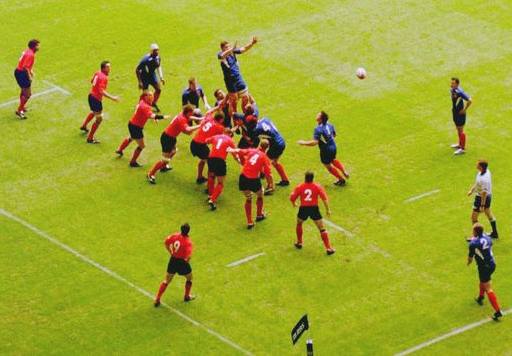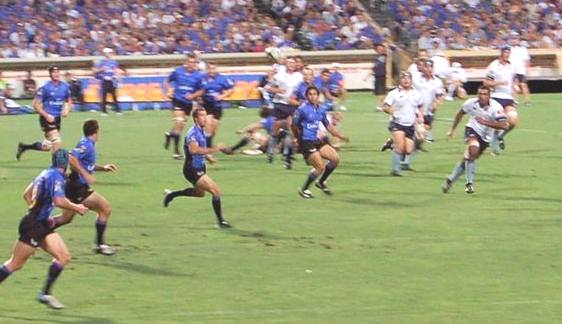|
RUGBY UNION
|
||
|
HOME | BIOLOGY | FILMS | GEOGRAPHY | HISTORY | INDEX | MUSIC | SOLAR BOATS | SPORT | SPONSORS |
||
|
Rugby union (often referred to as just rugby, or union) is a variant of rugby football. Rugby union is normally played by teams with 15 players, although there is also rugby sevens, a quicker game with 7 players a side. The name comes from the name of the game's original governing body, the Rugby Football Union.
Like other forms of rugby football the game was developed from the rules used to play football at Rugby school in England. The crucial differences from football (soccer) are that in rugby the ball is a prolate spheroid instead of a sphere and that the players are allowed to pick the ball up and run with it. The players are also allowed to throw the ball from player to player, but unlike American football they are not allowed to throw it forwards, it must only go sideways or backwards.
Rugby union - Lineout
Rugby union was founded in England, in 1823. It has established itself as the national sport in New Zealand, Fiji, Tonga, Samoa and Wales, and is a popular sport in England, Ireland, Scotland, France, Australia, Argentina and South Africa. Rugby is also gaining popularity in Italy and Japan, following Italy's acceptance into the Six Nations and Japan's unsuccessful bid to host 2011 Rugby World Cup, which will be hosted in New Zealand.
The International Rugby Board (IRB), founded in 1886, governs the sport and also publishes the game's laws. There are currently 95 full members and 8 associate member countries. The IRB controls the Rugby World Cup, the Women's Rugby World Cup, Rugby World Cup Sevens, IRB World Sevens Series, Under 21 World Cup, Under 19 World Championship, and the Super Powers Cup. It will hold votes to decide where these events shall be held.
Overview
A rugby union match lasts for 80 minutes (two halves of 40 minutes each) and is controlled by a referee, usually assisted by two touch judges. Each team alternately attacks the opposition goal or defends their own. These goals are marked at each end of the pitch by a pair of tall (typically 10 m or more) posts set 5.6 m apart, and connected by a cross-bar at 3 m above the ground; the whole forming the approximate shape of a letter H. The attacking team may score by kicking the ball between the posts and above the cross-bar. However the ball may only be kicked from the ground: either from a place kick following the award of a penalty or from a drop kick in open play. A successful kick at goal is worth three points. The area behind each set of goal posts is called the "in goal area" and the attacking team may also score by grounding the ball in this area. This is called a "try" and is worth five points. After scoring a try, the attacking team are awarded a free kick at goal for an extra two points.
For the purist, a try is the main form of scoring, and the primary aim of most attacking teams is to score tries. Drop goals and penalty kicks are usually augmentors, a last resort against a steadfast defense or to punish ill-disciplined opposition. In reality, close games -- even those in which many tries are scored -- are frequently won and lost on the relative success of the goal kickers.
The sport is closely related to rugby league. The main differences from rugby league are the number of players per side (league has 13, union 15), the scoring system, and the means of securing and retaining possession of the ball (in union, both teams may contest possession at a tackle or set piece; in league one team retains possession for six tackles. Rugby union is also related to rugby sevens, which the game's governing body the IRB also runs, as well as American football and Canadian football, which are directly descended from rugby football.
Rugby union - Backplay
LINKS:
Official
News and resources
LINKS:
A - Z SPORTS INDEX
A taste for adventure capitalists
Solar Cola - a healthier alternative
|
||
|
This
website
is Copyright © 1999 & 2006 NJK. The bird |
||
|
AUTOMOTIVE | BLUEBIRD | ELECTRIC CARS | ELECTRIC CYCLES | SOLAR CARS |

